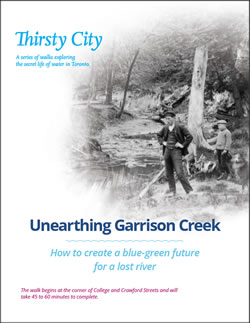Unearthing Garrison Creek
How to create a blue green future for a lost river
In the 1980s, architects James Brown and Kim Storey mapped lost Garrison Creek, the beginning of a communal love affair with its memory. They wanted to bring the Garrison back as a natural system to handle stormwater. Practical, economic, social, and political barriers intervened, but the creek, now firmly entrenched in local sentiment and mythology, lives on in green links, the parks along its path, in curving streets, in the sound of water rushing under streets and in creative community projects.
The idea of using nature as the design template for remaking cities has taken hold since then, and new technologies are being applied to create living buildings and blue green infrastructure. The environmental, social and cultural benefits are many, including reduced flooding and climate change impacts.
On this walk discover possibilities for a blue green future for Garrison Creek and learn about the David Suzuki Foundation project to create a "Homegrown National Park" in the watershed of lost Garrison Creek.
Support for this self-guided tour has been generously provided by
Unearthing Garrison Creek Partners
Glossary
Plant Vascular System - Conducting tissues and associated supportive fibres that transport water and minerals between roots and leaves.
Rain Garden - A landscaped feature with plants and loose, deep soil that absorbs and naturally filters stormwater runoff, preventing it from entering the storm drain system and waterways.
Transpiration – The passage of water through a plant from roots through the vascular system to the leaves and then to the atmosphere.
Living Building - A structure that generates all of its own energy with renewable nontoxic resources, captures and uses rainwater, treats all its water on site, and minimizes waste.
Blue Green City - A city that integrates water management and green infrastructure aiming for a naturally-oriented water cycle and enhanced natural habitats. This strategy builds resilience to climate change and at the same time enhances quality of life and amenity in the city.
Source Controls – The most effective way to prevent pollution and flash floods is to avoid it at the moment rain falls on the ground. Runoff volume and prevent contaminants from entering the water system If rain is captured, filtered, and re-used where it falls, overland run-off is reduced, and contaminants can be prevented from entering the water system.
Conveyance Controls - Stormwater conveyance systems are drainage ditches and swales, concrete channels, more naturalized channels and pipes. Control measures slow water down and allow it to soak into the ground, for example: concrete channels can be re-naturalized, leaky pipes can allow some water to enter the water table, grassed swales can be landscaped, and pervious catch basins.
End of Pipe Holding Tanks – Large underground storage tanks designed to allow contaminants to settle out at the end of the conveyance system and before the water enters the lake. Often there is a further action to treat the water such as UV sterilization; called ‘end-of-pipe' because they happen at the end of the conveyance system before stormwater or mixed storm water and sewage enter the lake.
CSO - A combined sewer collects and transports a mixture of both sanitary wastewater and stormwater runoff in a single pipe. However, during heavy rain storms or snow melts, the combined sewer cannot handle the high volume of stormwater runoff entering the system, in addition to wastewater.
Combined Sewer - A single pipe that carries storm water and sanitary sewage in sub channels.
Storm Sewer - A sewer built to carry away excess water in times of heavy rain.
Sanitary Sewer - A sewer that transports black water (from toilets) and grey water (from laundry, kitchen, bathtubs etc.) to a sewage treatment plant.
CSO - A combined sewer overflow occurs when heavy rain storms or snow melts overwhelm the capacity of the pipe: sanitary sewage and storm water mix together and overflow untreated into rivers and the lake.
Butterfly Milkweed Corridor - Monarch butterfly migration takes place through several generations between Mexico and Canada. Each generation must eat milkweed leaves in the larval stage. Right now monarch populations have dropped by as much as 90% over the past 10 years, in part because of loss of milkweeds in their migration route. To help the monarchs citizens all over North America are working to create a "milkweed corridor" along their migration route from Northern Ontario through the cornbelt, Texas and into Mexico.
Natural Linkage - Natural linkages, also known as wildlife corridors or eco-corridors, are natural areas, or greenspace, that allow plants and animals to migrate from one habitat to another. Agricultural and urban land uses encroach on wildlife habitats, isolating them from the larger environment into disconnected “habitat islands” or pockets of greenspace. By creating natural linkages into agricultural and urban lands, eco-connectivity between these “islands” can be enhanced and the chances for survival of more species are increased.
Ecosystem Function - The energy flows, water flows, water budget, biogeochemical cycles, soil development, in relation to living species in an ecosystem over time.





